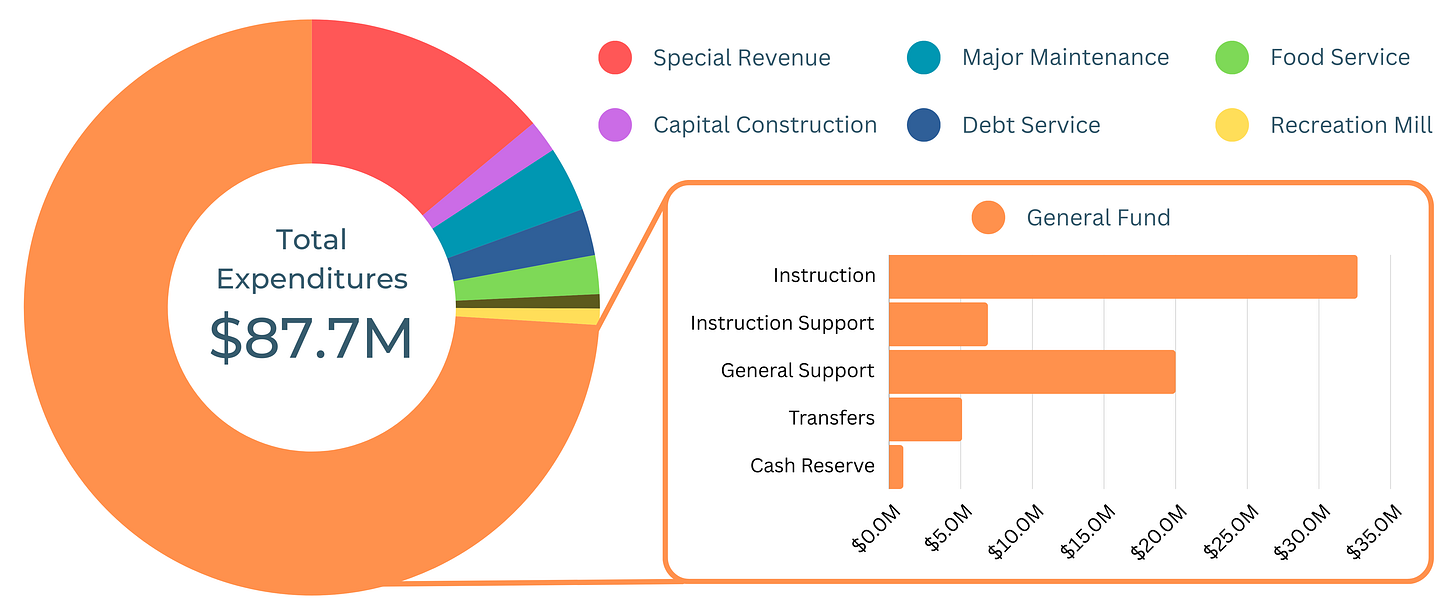Albany County School Board approves $88 million annual budget
This year’s budget includes permanent raises, made possible by a “reduction in force.” It also uses a $3.2 million surplus to establish a special reserve fund and give a one-time districtwide bonus.

The Albany County School Board approved a district budget for the current fiscal year earlier this month, adopting a plan that will give teachers raises, provide one-time bonuses to all employees, and start to realize the financial benefits of shuttering the district’s oldest elementary school.
The budget is in a strong place after several tough years.
To be clear, challenges lie ahead — such as falling contributions from the state, the imminent end of pandemic-era federal assistance, and declining student head counts — but the new 12-month budget enables the district to start better compensating teachers and start planning for the future.
During a presentation about the budget on July 17, Albany County Schools CFO Trystin Green told the school board the district now has surplus.
“In total, you have $2 million more in revenue and $3.2 million less in expenditures,” she said. “Everybody did everything possible to spend based on needs. Not once did they spend their full budgets, they didn't spend unwisely, and we tried to find efficiencies within the year.”
That has put the district in a strong position, Green said.
“Because of that, you only spent about 95% of our budget,” she said. “Which is a perfect budget if you ask me. You really should only be spending 95-97% of your budget, because that other 3-5% is leaving room for error and any unforeseen circumstances.”

The $2 million extra in revenue is offset by entitlement funds, Green said, but the $3.2 million surplus on the other side of the ledger gives the district money to work with.
While it might seem obvious to throw that surplus into cash reserves, hanging onto it for less rosy days in the future, Green said the district is limited in what it can actually keep as cash on hand and the full $3.2 million would push the current cash reserves beyond that limit. Nor can the surplus be rolled over to the next year.
“You can’t put all of that and just leave it to cash reserves,” Green said. “We have to do some other things with that $3.2 million.”
Green proposed, and the board ultimately approved, a plan to divvy up those savings, by putting:
About $1 million in cash reserves;
About $1 million in a new special reserve fund, which will be further divided into two sub-funds — one a “depreciation” fund to purchase and replace vehicles, technology and athletic equipment, the other a “special building fund” for covering capital facility costs not covered by the School Construction Department;
About $1.1 million toward one-time $1,400 bonuses for every employee in the district, regardless of full-time or part-time status.
Goldhardt said this was all made possible by those across the district who tightened their budgets and lived within their means this past year.
“It was not an easy task to do,” Goldhardt told the Laramie Reporter. “There were a lot of people who worked really hard and collaborated to make it work so that we could come from being in a deficit to now having some surplus that we can put into savings — for not only our cash reserves, but also reserves for future maintenance costs that aren't covered by the state.”
The new special reserve fund should not be confused with the district’s “cash reserves.” The new fund is a pool of money socked away for a specific goal; cash reserves are simply the “cash-on-hand” that can be used to cover expenses which will be reimbursed later or to respond to unpredictable emergencies, such as lawsuits. The amount held by the district as cash reserves fluctuates significantly from month to month.
“[Cash reserves] are set aside for cash flow and unforeseen circumstances, but they’re not set aside for specific purposes,” Green said. “So it’s never: ‘We’re keeping this million in cash reserves for this purpose. And we’re keeping this in here for this purpose.’ If you want to have specific purposes for things, you put that in a special reserve fund.”
With some of this year’s surplus, the district is doing just that.
The one-time $1,400 bonuses come on top of permanent raises that almost all employees throughout the district are receiving this year. In February, the school board approved a $3/hour raise for classified employees and a $2,500/year raise for certified staff, and those raises are also accounted for in the budget passed this month.
Both Superintendent John Goldhardt and the trustees said raises were necessary to more adequately compensate teachers and other staff, but they came at a cost. The district simultaneously enacted a “reduction in force” plan, seeking to eliminate about 15 positions through attrition or termination.
In the end, the district reduced its workforce by the equivalent of 16-18 full-time employees. But that doesn’t mean 16-18 people were fired.
“The majority of those were through attrition, people who had either resigned, left or retired,” Goldhardt said.
The district advertised a $10,000 retirement incentive when it committed to the reduction in force. In total, 21 employees took that incentive. However, many of these positions were positions that had to be replaced, so the end result is not 21 fewer employees.
Eight employees were delivered a notice of termination for budgetary reasons, according to figures shared by Chief Human Resources Officer Nathan Cowper. Four of these were released from one-year contracts, two were hired back to fill vacant positions, another initial contract teacher was hired back to fill another position, and a continuing contract teacher saw their position reduced by one third of an FTE and remains a classified employee.
At the same July meeting, trustees passed a personnel recommendation which gave $5,000 raises to some special education teachers identified as specifically working with students with the highest needs. Some trustees argued this raise would be unfair, singling out one class of professionals for a raise instead of looking systematically at all salaries and making adjustments holistically.
But the majority argued this raise could be sufficiently justified.
“When we recognize that there’s a specialized group in our district serving a special population with higher needs, the answer to creating equity isn’t to not recognize the extra duty of those employees,” Trustee Emily Siegel-Stanton said. “The answer is [to] take a good look and keep looking around the district for where we can bump people up and compensate them for the jobs that they are doing.”



